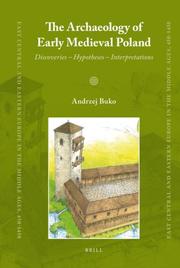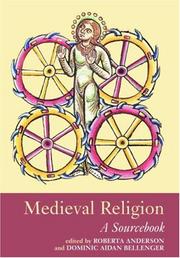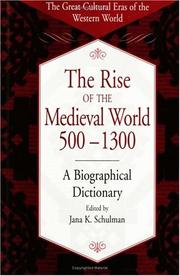| Listing 1 - 10 of 18 | << page >> |
Sort by
|

ISBN: 1281936774 9786611936778 9047423267 9789047423263 6611936777 9004162305 9789004162303 Year: 2008 Publisher: Leiden Boston
Abstract | Keywords | Export | Availability | Bookmark
 Loading...
Loading...Choose an application
- Reference Manager
- EndNote
- RefWorks (Direct export to RefWorks)
This is the first academic book which concentrates on the discoveries of medieval date (6th- 13th centuries) from the territory of modern Poland. The book covers the principal research questions, such as the origins of the Slavs, societies of the proto-state period and the origins of the Polish state. The volume also includes a discussion of the most interesting, sometimes controversial, archaeological discoveries or issues. These include pagan Slavonic holy places, the monumental mounds of Little Poland, the first traces of medieval writing, exceptional strongholds, the origins of Polish towns, rural landscapes, archaeology of the oldest monastic complexes, and the question of locals and aliens viewed through archaeological evidence and many other topics. The book is meant mainly for students, archaeologists and historians. It can also be useful for a wider audience interested in the history and archaeology of central Europe. In November 2006 'The Archaeology of Early Medieval Poland' received the KLIO Award from the Association of Polish History Publishers.
Archäologie --- Archäologie. --- Archaeology, Medieval --- Excavations (Archaeology) --- Antiquities, Medieval --- Medieval antiquities --- Medieval archaeology --- Geschichte 1000-1500 --- Geschichte 500-1000 --- Geschichte 500-1300 --- Geschichte --- Polen --- Polen. --- Poland --- Antiquities. --- History.
Book
ISBN: 9781842173817 9781782973706 1782973702 9781782973720 1782973729 1842173812 Year: 2009 Volume: 6 Publisher: Oxford Oxbow
Abstract | Keywords | Export | Availability | Bookmark
 Loading...
Loading...Choose an application
- Reference Manager
- EndNote
- RefWorks (Direct export to RefWorks)
The eight papers presented here provide a useful introduction to medieval broadcloth, and an up-to-date synthesis of current research. The word broadcloth is nowadays used as an overall term for the woven textiles mass-produced and exported all over Europe. It was first produced in Flanders as a luxurious cloth from the 11th century and throughout the medieval period. Broadcloth is the English term, Laken in Flemish, Tuch in German, Drap in French, Klæde in the Scandinavian languages and Verka in Finish. As the concept of broadcloth has deriving from the written sources it cannot directly be identified in the archaeological textiles and therefore the topic of medieval broadcloth is very suitable as an interdisciplinary theme. The first chapter (John Munro) presents an introduction to the subject and takes the reader through the manufacturing and economic importance of the medieval broadcloth as a luxury item. Chapter two (Carsten Jahnke) describes trade in the Baltic Sea area, detailing production standards, shipping and prices. Chapters three, four and five (Heini Kirjavainen, Riina Rammo and Jerzy Maik) deal with archaeological textiles excavated in the Baltic, Finland and Poland. Chapters six and seven (Camilla Luise Dahl and Kathrine Vestergård Pedersen) concern the problems of combining the terminology from the written sources with archaeological textiles. The last chapter reports on an ongoing reconstruction project; at the open air museum in Eindhoven, Holland, Anton Reurink has tried to recreate a medieval broadcloth based on written and historical sources. During the last few years he has reconstructed the tool for preparing and spinning wool, and a group of spinners has produced a yarn of the right quality. He subsequently wove approximately 20 metres of cloth and conducted the first experiment with foot-fulling.
Manufacturing technologies --- Applied arts. Arts and crafts --- anno 500-1499 --- Textile fabrics, Medieval. --- Textile industry and fabrics --- Textile industry --- History --- History. --- Textile fabrics, Medieval --- Medieval textile fabrics --- Geschichte 500-1500. --- Textile industry -- History. --- Mechanical Engineering --- Engineering & Applied Sciences --- Industrial & Management Engineering --- Textiles industry --- Manufacturing industries --- Geschichte 500-1500
Periodical
ISSN: 11378905 2660891X
Abstract | Keywords | Export | Availability | Bookmark
 Loading...
Loading...Choose an application
- Reference Manager
- EndNote
- RefWorks (Direct export to RefWorks)
Spanish poetry --- Poetry, Medieval --- Poetry, Medieval. --- Spanish poetry. --- Dichtkunst. --- Middeleeuwen. --- Literatur --- Zeitschrift --- History and criticism --- Geschichte 500-1500 --- To 1500 --- Spanien --- Altspanisch. --- Arts and Humanities --- Literature --- medieval literature --- medieval poetry --- medieval linguistics --- Geschichte 500-1500. --- Periodikum --- Zeitschriften --- Presse --- Fortlaufendes Sammelwerk --- Belletristik --- Dichtung --- Schöne Literatur --- Sprachkunst --- Wortkunst --- Buch --- Schriftsteller --- Spanish literature --- Medieval poetry --- European poetry --- Isbāniyā --- Spain --- Espagne --- Estado Español --- España --- Espanja --- Hispania --- Spanier --- Iberische Halbinsel

ISBN: 9780415370288 9780415370271 0415370280 0415370272 1134372922 1134372930 9786610267491 1280267496 0203328671 9780203328675 9780415316866 0415316863 9780415316873 0415316871 6610267499 0415316863 0415316871 9781134372935 9781280267499 Year: 2007 Publisher: London Routledge
Abstract | Keywords | Export | Availability | Bookmark
 Loading...
Loading...Choose an application
- Reference Manager
- EndNote
- RefWorks (Direct export to RefWorks)
Constance Berman presents an indispensable new collection of the most influential and revisionist work to be done on religion in the middle ages in the last couple of decades.
Christian church history --- anno 500-1499 --- Church history --- Eglise --- Sources --- Histoire --- 27 "04/14" --- Kerkgeschiedenis--Middeleeuwen --- Religion --- Christendom. --- Middeleeuwen. --- Religion. --- History. --- Religious history --- Christianity --- Middle Ages, 600-1500 --- Geschichte 500-1500 --- History --- Histoire de l'Eglise--Middeleeuwen --- #A0510HI --- Church history - Middle Ages, 600-1500. --- Religion - History.
Book
ISBN: 9780198704058 0198704054 0191773158 0191009024 0198865813 9780191009020 9780191773150 Year: 2017 Publisher: Oxford, United Kingdom
Abstract | Keywords | Export | Availability | Bookmark
 Loading...
Loading...Choose an application
- Reference Manager
- EndNote
- RefWorks (Direct export to RefWorks)
Slavery After Rome, 500-1100' offers a substantially new interpretation of what happened to slavery in Western Europe in the centuries that followed the fall of the Roman Empire. The periods at either end of the early middle ages are associated with iconic forms of unfreedom: Roman slavery at one end; at the other, the serfdom of the twelfth century and beyond, together with, in Southern Europe, a revitalised urban chattel slavery dealing chiefly in non-Christians. How and why this major change took place in the intervening period has been a long-standing puzzle. This study picks up the various threads linking this transformation across the centuries, and situates them within the full context of what slavery and unfreedom were being used for in the early middle ages. This volume adopts a broad comparative perspective, covering different regions of Western Europe over six centuries, to try to answer the following questions: who might become enslaved and why? What did this mean for them, and for their lords? 0What made people opt for certain ways of exploiting unfree labour over others in different times and places, and is it possible, underneath all this diversity, to identify some coherent trajectories of historical change?
Sklaverei. --- Geschichte 500-1100. --- Westeuropa. --- Slavery --- Serfdom --- History --- Esclavage --- Servage --- Histoire --- Slavery - Europe, Western - History - To 1500 --- Serfdom - Europe, Western - History - To 1500 --- History. --- To 1500 --- Europe, Western. --- Servitude --- Forced labor --- Land tenure --- Villeinage --- Law and legislation --- Europe, Western --- West Europe
Book
ISBN: 9789004170834 9004170839 9786612400070 128240007X 904742414X 9789047424147 Year: 2009 Volume: 80 Publisher: Leiden Boston : Brill,
Abstract | Keywords | Export | Availability | Bookmark
 Loading...
Loading...Choose an application
- Reference Manager
- EndNote
- RefWorks (Direct export to RefWorks)
A broad survey of the various structural and decorative uses of marble and antiquities throughout the Mediterranean during the Millennium following the Emperor Constantine. The heavy footprint of Roman civic and religious architecture helped provide attractive and luxurious building materials, re-used to construct diverse and often sophisticated monuments. The book argues that marble-rich sites and cities around this lake were linked at various times and in varying degrees by trade, pilgrimage, war and diplomacy, as well as by the imperatives of religion - Venice to Alexandria, Damascus to Córdoba. Aachen makes less sense without reference to Rome or Jerusalem; Damascus without Kairouan; Istanbul without Cairo. To accompany the illustrations in the text, the DVD at the back of the book contains over 5,000 images, together with discussions which extend various arguments in the printed book.
Marble buildings --- Architecture, Medieval --- Marble --- Constructions en marbre --- Architecture médiévale --- Marbre --- Recycling --- Recyclage --- Mediterranean Region --- Méditerranée, Région de la --- Antiquities, Roman. --- Antiquités romaines --- Antiquities, Roman --- Architecture médiévale --- Méditerranée, Région de la --- Antiquités romaines --- Antike. --- Architektur. --- Marmor. --- Spolie. --- Metamorphic rocks --- Calcium carbonate --- Buildings --- Geschichte 1000-1500 --- Geschichte 500-1000 --- Mittelmeerraum. --- Circum-Mediterranean countries --- Mediterranean Area --- Mediterranean countries --- Mediterranean Sea Region --- Marble buildings - Mediterranean Region --- Architecture, Medieval - Mediterranean Region --- Marble - Recycling - Mediterranean Region --- Mediterranean Region - Antiquities, Roman
Periodical
ISSN: 14740087 09611371
Abstract | Keywords | Export | Availability | Bookmark
 Loading...
Loading...Choose an application
- Reference Manager
- EndNote
- RefWorks (Direct export to RefWorks)
Music --- Gregorian chants --- Gregorian chants. --- History and criticism --- 500-1400 --- Cantus planus --- Monodie --- Musik --- Geschichte 500-1600 --- Einstimmiger Gesang --- Plain-chant --- Plainchant --- Ancient music --- Music, Ancient --- Chant (Plain, Gregorian, etc.) --- Chants (Plain, Gregorian, etc.) --- Franco-Roman chants --- Gregorian chant --- Old Roman chants --- Plainchants --- Plainsong --- Roman chants --- Art music --- Art music, Western --- Classical music --- Musical compositions --- Musical works --- Serious music --- Western art music --- Western music (Western countries) --- Culture and media --- Gesang --- Gregorianischer Gesang --- Liturgics --- Chants

ISBN: 0203166000 0415267595 9780203166000 9780415267595 0415862949 1280182008 1134498659 9786610182008 6610182000 9780415862943 9781280182006 9781134498659 9781134498604 9781134498642 1134498640 Year: 2002 Publisher: London Routledge
Abstract | Keywords | Export | Availability | Bookmark
 Loading...
Loading...Choose an application
- Reference Manager
- EndNote
- RefWorks (Direct export to RefWorks)
This volume discusses, from an historical and literary angle, the ways in which sanctification and the inscription of saintliness take place. Going beyond the traditional categories of canonization, cult, liturgical veneration and hagiographical lives, the work raises fundamental issues concerning definitions of saints and saintliness in a period before the concept was crystallized in canon law. As well as discussing sources and methodology, contributions cover contextual issues, including relics and veneration, life and the afterlife, and examinations of specific sources and texts. Subjects r
Heiligen. --- Heiliger. --- Heiligkeit. --- Sanctification --- Christianity --- History of doctrines --- Geschichte 500-1500. --- -235*4 --- Holiness --- Perfection --- -Heiligheid--(theologische aspecten) --- 235*4 Heiligheid--(theologische aspecten) --- Heiligheid--(theologische aspecten) --- 235*4 --- Religion --- Religious aspects --- Christian church history --- History as a science --- Saints --- Histoire des doctrines --- Middle Ages, 600-1500 --- Middle Ages, 500-1500 --- Sanctification - Christianity - History of doctrines - Middle Ages, 600-1500. --- Arnulfus ep. Suessionensis --- Sainteté --- Godeleva v. m. Ghistellae --- Alexius conf. Edessae et Romae --- Bernwardus ep. Hildesheimensis

ISBN: 0313308179 9780313308178 0313011087 9780313011085 1280637110 9781280637117 9786610637119 6610637113 9798216009238 Year: 2002 Publisher: Westport Greenwood
Abstract | Keywords | Export | Availability | Bookmark
 Loading...
Loading...Choose an application
- Reference Manager
- EndNote
- RefWorks (Direct export to RefWorks)
"Beginning in 500 with the fusion of classical, Christian, and Germanic cultures and ending in 1300 with a Europe united by a desire for growth, knowledge, and change, this volume provides basic information on the significant cultural figures of the Middle Ages. It includes over 400 people whose contributions in literature, religion, philosophy, education, or politics influenced the development and culture of the Medieval world. While focusing on Western European figures, the book does not neglect those from Byzantium, Baghdad, and the Arab world who also contributed to the politics, religion, and culture of Western Europe."--Jacket.
929 "04/14" --- Biography --- -Civilization, Medieval --- Civilization, Medieval --- Medieval civilization --- Middle Ages --- Civilization --- Chivalry --- Renaissance --- 929 "04/14" Biografieën: verzamelbiografieën: Middeleeuwen --- Biografieën: verzamelbiografieën: Middeleeuwen --- Biographies --- History --- Life histories --- Memoirs --- Auxiliary sciences of history --- Genealogy --- #A0302H --- Europe --- Council of Europe countries --- Eastern Hemisphere --- Eurasia --- -929 "04/14" --- -Biography --- Civilisation médiévale --- Dictionaries --- Dictionnaires anglais --- Dictionnaires --- Histoire --- Biographie --- Biografie. --- Biography. --- Civilisation médiévale --- Civilization, Medieval. --- Middeleeuwen. --- Middle Ages. --- Dictionnaires anglais. --- 476 - 1500. --- Geschichte 500-1300. --- Europa. --- Europe. --- Dictionaries.
Book
ISBN: 9780521519113 052151911X 9780511581090 9781107412613 9780511580772 0511580770 0511580452 9780511580451 0511579241 9780511579240 1107191904 1107412617 1282302914 9786612302916 0511581092 0511578504 0511579985 Year: 2009 Volume: 75 Publisher: Cambridge Cambridge University Press
Abstract | Keywords | Export | Availability | Bookmark
 Loading...
Loading...Choose an application
- Reference Manager
- EndNote
- RefWorks (Direct export to RefWorks)
The autobiographical and confessional writings of Abelard, Heloise and the Archpoet were concerned with religious authenticity, spiritual sincerity and their opposite - fictio, a composite of hypocrisy and dissimulation, lying and irony. How and why moral identity could be feigned or falsified were seen as issues of primary importance, and Peter Godman here restores them to the prominence they once occupied in twelfth-century thought. This book is an account of the relationship between ethics and literature in the work of the most famous authors of the Latin Middle Ages. Combining conceptual analysis with close attention to style and form, it offers a major contribution to the history of the medieval conscience.
Christian moral theology --- Christian church history --- Petrus Abaelardus --- Heloise --- Conscience --- Christian ethics --- Conscience (Morale) --- Morale chrétienne --- Religious aspects --- Christianity --- History --- Aspect religieux --- Christianisme --- Histoire --- Abelard, Peter, --- Héloïse, --- Conscience. --- Christliche Ethik --- Gewissen --- Fictionaliteit --- Integriteit --- Spiritualiteit --- Catholic Church. --- Abaelardus, Petrus --- Geschichte 500-1500. --- Ethics --- Guilt --- Superego --- Middle Ages, 600-1500 --- Heloise, --- Abaelard, Peter, --- Abaelardi, Petri, --- Abaelardus, --- Abaelardus, Petrus, --- Abailard, Peter, --- Abailard, Pierre, --- Abailardus, Petrus, --- Abeilard, Pierre, --- Abélard, Pierre, --- Abelard, Piotr, --- Abelardo, --- Abelardo, Pietro, --- Abeli︠a︡r, Petr, --- Abelʹi︠a︡rd, Petr, --- אבעלאר, --- Christliche Ethik. --- Gewissen. --- Fictionaliteit. --- Integriteit. --- Spiritualiteit. --- Abaelardus, Petrus. --- Morale chrétienne --- Héloïse, --- Religious aspects&delete& --- Catholic Church --- Ėloiza, --- Eloisa, --- Heloísa, --- Arts and Humanities --- Literature
| Listing 1 - 10 of 18 | << page >> |
Sort by
|

 Search
Search Feedback
Feedback About UniCat
About UniCat  Help
Help News
News